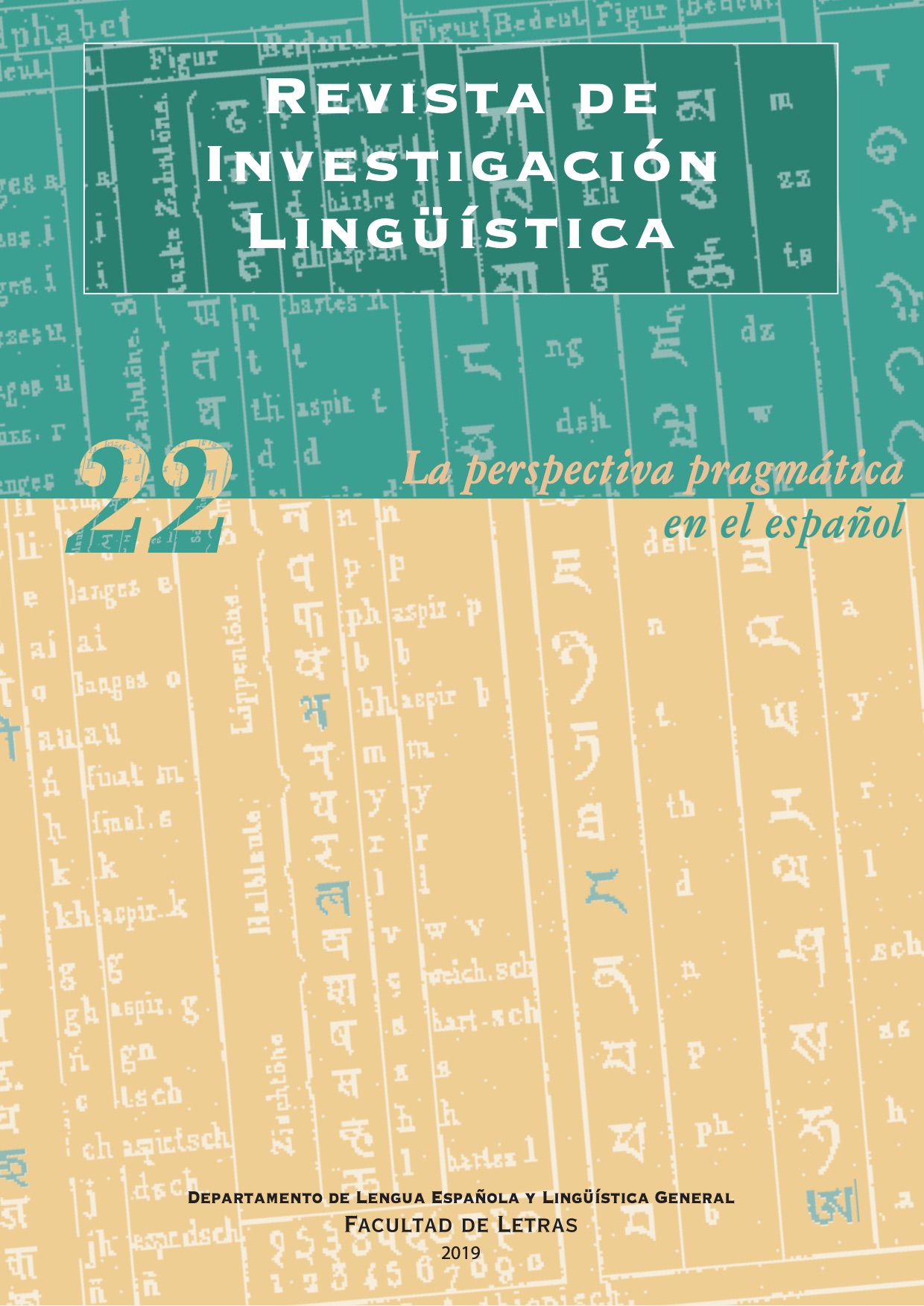(Cualitative and cuantitative) subsectivity: a matter of lexical semantics
Abstract
Resumen: Resulta frecuente encontrar aproximaciones a los adjetivos que consideran intersectivos casos como bueno o hábil cuando estos se emplean con su significado más general; es decir, cuando este no viene restringido por el sustantivo con el que se relacionan. En She is a beautiful dancer se entiende que beautiful es intersectivo si se asume que ella (she), además de ser bailarina, es también beautiful como persona. Mientras, si se interpreta que beautiful restringe a dancer, y que ella es beautiful en su faceta de bailarina, se considera que el adjetivo actúa de forma subsectiva. En este trabajo presentaremos la distinción subsectividad/intersectividad como una cuestión de semántica léxica sin relación con las estructuras gramaticales de las que formen parte los adjetivos.
Downloads
References
BAKER, Mark C. (2003): Lexical Categories. Verbs, Nouns, and Adjectives, Cambridge, Cambridge Studies in Linguistics.
CABREDO HOFHERR, Patricia (2010): «Adjectives. An introduction», en Patricia Cabredo Hofherr y Ora Matushansky (eds.), Adjectives. Formal analyses in syntax and semantics, Ámsterdam, John Benjamins Publishing Company, pp. 1-28.
CHIERCHIA, Gennaro. y MCCONNELL-GINET, Sally (1990): Meaning and Grammar. An Introduction to Semantics, Cambridge, The MIT Press.
CINQUE, Guglielmo (2010): The Syntax of Adjectives. A Comparative Study, Cambridge, The MIT press.
DEMONTE, Violeta (1999): «El adjetivo», en Ignacio Bosque y Violeta Demonte (dirs.), Gramática descriptiva de la lengua española, vol. I, Madrid, Real Academia Española / Espasa Calpe, pp. 129-218.
DEMONTE, Violeta (2008): «Meaning-form correlations and adjective position in Spanish», en Louise McNally y Christopher Kennedy (eds.), Adjectives and adverbs. Syntax, Semantics and Discourse, Oxford, Oxford University Press, pp. 71-100.
EVANS, Vyvyan. y GREEN, Melanie (2006): Cognitive Linguistics: An Introduction, Edimburgo, Edinburgh University Press.
FERNÁNDEZ ROVIRA, Raquel (2011): «Incremental Resolution of Relative Adjectives: A DRT-based Approach», en Proceedings of the Workshop Constraints in Discourse. En línea: https://staff.fnwi.uva.nl/r.fernandezrovira/papers/2011/relative-cid2011.pdf [15/03/2019].
FUNK, Alexandre (2015): A Syntactic Treatment of Adjectival Non-Intersectivity in English, Tesis Doctoral, University of New York. En línea: https://pdfs.semanticscholar.org/6ccb/3a29dcb72524ef2efa36910c224066ba2094.pdf [17/05/2019].
GRICE, Herbert Paul (1989[1957]): Studies in the way of words, Cambridge, Harvard University Press.
HOEPELMAN, Jaap (1986): Action, Comparison and Change: Study in the Semantics of Verbs and Adjectives, Tübingen, Niemeyer.
HUDDLESTON, Rodney y PULLUM, Geoffrey K (2002): The Cambridge Grammar of the English Language, Cambridge, Cambridge University Press.
KAMP, Hans (1975): «Two Theories About Adjectives», en Edward Keenan (ed.), Formal semantics of Natural Language. Papers from a colloquium sponsored by the King's College Research Centre, Cambridge, Cambridge University Press, pp 123-155.
KAMP, Hans. y PARTEE, Barbara (1995): «Prototype theory and compositionality», Cognition, 57, pp. 129-191.
KLEIN, Ewan (1980): «A Semantics for Positive and Comparative Adjectives», Linguistics and Philosophy, 4, pp. 1-45.
LYONS, John (1977): Semantics, vol. 1, Cambridge, Cambridge University Press.
MARTÍN, Juan (2009): «A Constructionist Approach to Adjectival Interpretative Properties», en Joseph Collentine, Maryellen García, Barbara Lafford y Francisco Marcos Marín, Selected Proceedings of the 11th Hispanic Linguistics Symposium, Somreville, Cascadilla Proceedings Project, pp. 231-241.
MONTAGUE, Richard Merritt (1970): «English as a formal language», en Bruno Visentini et al. (eds.), Linguaggi nella Societa et nella Technica, Milan, Edizioni di Communita, pp. 188-221.
NGLE = Real Academia Española y Asociación de Academias de la Lengua Española (2009): Nueva gramática de la Lengua Española, Madrid, Espasa.
Paoli, Francesco. (1999): «Comparative Logic as an Approach to Comparison in Natural Language», Journal of Semantics, 16(1), pp. 67-96.
PARSONS, Terence (1968): A semantics for English, Chicago, University of Illinois.
PARTEE, Barbara (2010): «Privative adjective: subsective plus coercion», en Rainer Bauerle, Uwe Reyle y Thomas Zimmermann (eds.), Presuppositions and Discourse: Essays Offered to Hans Kamp, Bradford, Emerald, pp. 273–285.
PUSTEJOVSKY, James (1995): The generative lexicon, Boston, The MIT Press.
REICHARD, Ulrich (2013): «Inference and Grammar: Intersectivity, Subsectivity, and Phases», en Catrin S. Rhys, Pavel Iosad y Alison Henry (eds.), Microvariation, Minority Languages, Minimalism and Meaning: Proceedings of the Irish Network in Formal Linguistics, Cambridge, Cambridge Scholars Press, pp. 222-244.
RODRÍGUEZ RAMALLE, Teresa María (2005): Manual de sintaxis del español, Madrid, Castalia Universidad.
ROMERO SANGÜESA, María Isabel (1994): «Los sintagmas adjetivos y la gramática de Montague», Actas del VIII Congreso Español de Estudios Clásicos, vol. 1, Madrid, Ediciones clásicas, pp. 733-738.
SIEGEL, Muffy E. A. (1980): Capturing the adjective. Outstanding Dissertations in Linguistics, Nueva York, Garland.
SUZUKI, Takao (1970): «An essay on the anthropomorphic norm», en Roman Jakobson y Shigeo Kawamoto (eds.), Studies in General and Oriental Linguistics, Tokyo, TEC, pp. 552-556.
TRIBUSHININA, Elena (2008): Cognitive reference points. Semantics beyond the prototypes in adjectives of space and colour, Utrecht, LOT.
YNDURÁIN, Carlos (2019): «El cálculo del valor cuantitativo de los adjetivos dimensionales», Diálogo de la Lengua, XI, pp. 1-14.
The works published in this magazine are subject to the following terms:
1. The Publications Service of the University of Murcia (the publisher) preserves the economic rights (copyright) of the published works, and favors and allows the reuse of same under the license of use indicated in point 2.
2. The papers are published in the electronic edition of the magazine under a Creative Commons Attribution-NonCommercial-NoDerivative 3.0 Spain license (legal text). Papers may be copied, used, disseminated, transmitted and publicly exhibited if the following requirements are met: i) The authorship and the original source of its publication (magazine, editorial and URL of the work) must be cited; ii) The works cannot be used for commercial purposes; iii) The existence and specifications of this user license must be explicitly mentioned.
3. Self-archiving conditions. Authors can electronically disseminate pre-print versions (version before being evaluated) and / or post-print versions (version evaluated and accepted for publication). This makes possible its circulation and diffusion earlier and with it a possible increase in its citation and reach among the academic community. RoMEO color: green.






